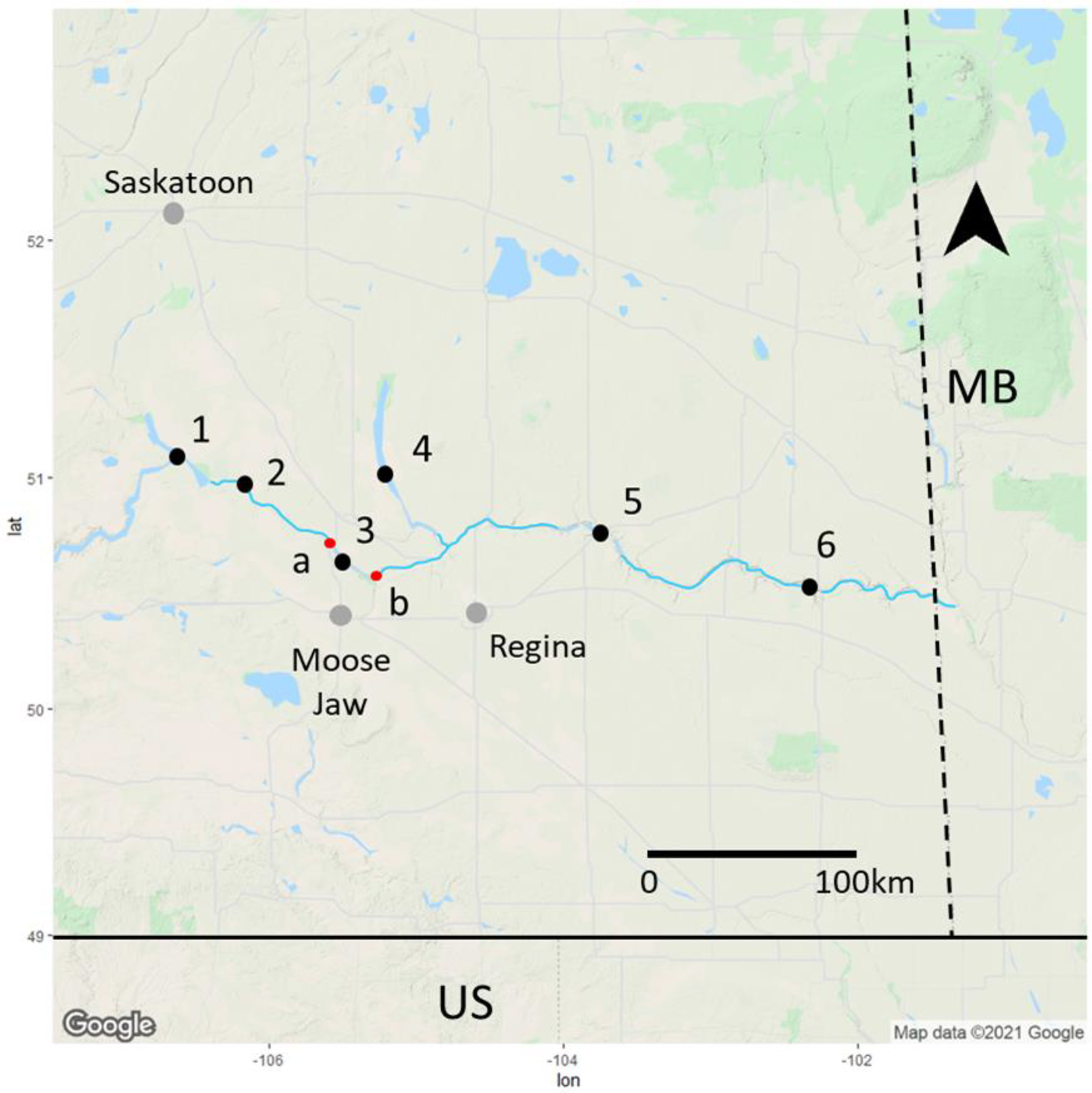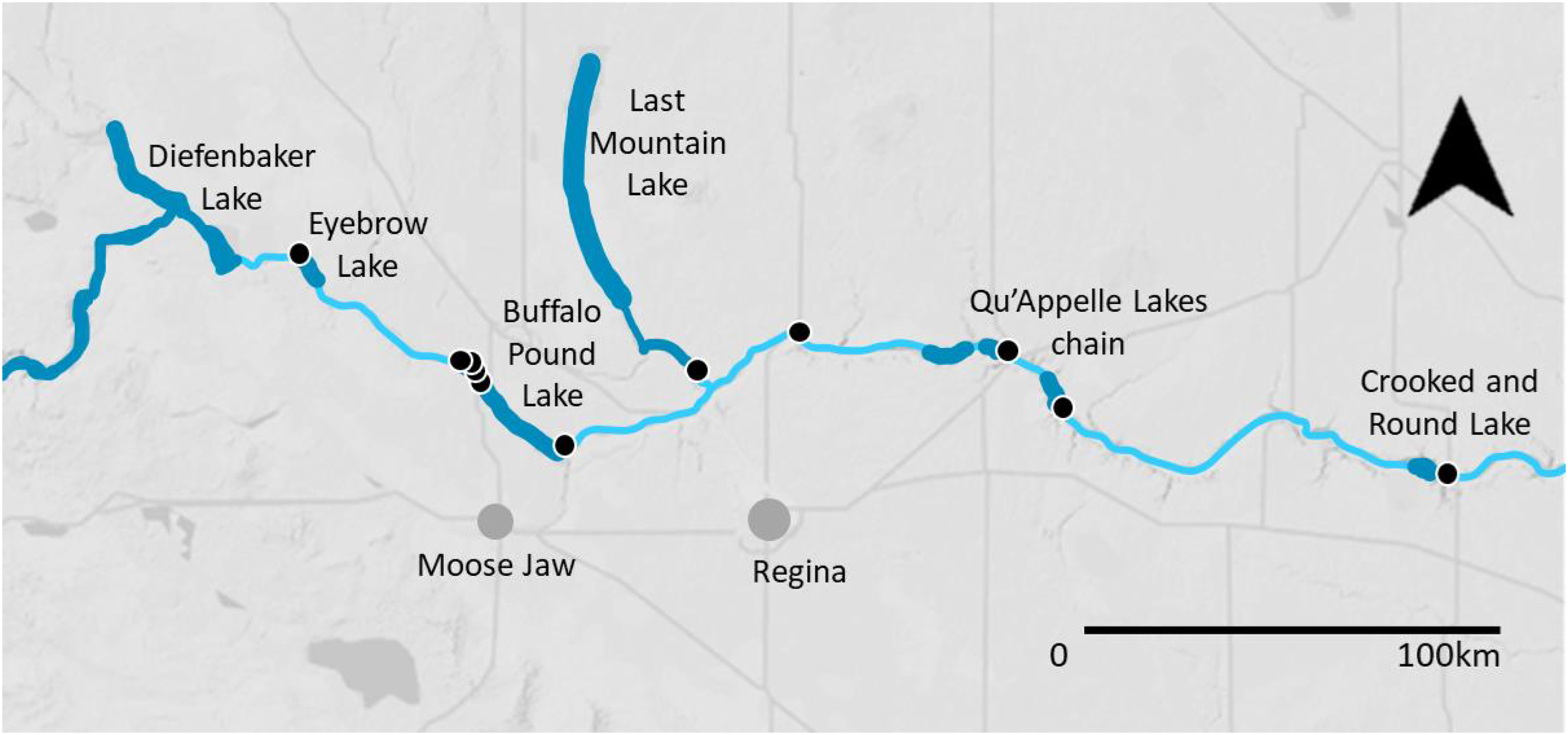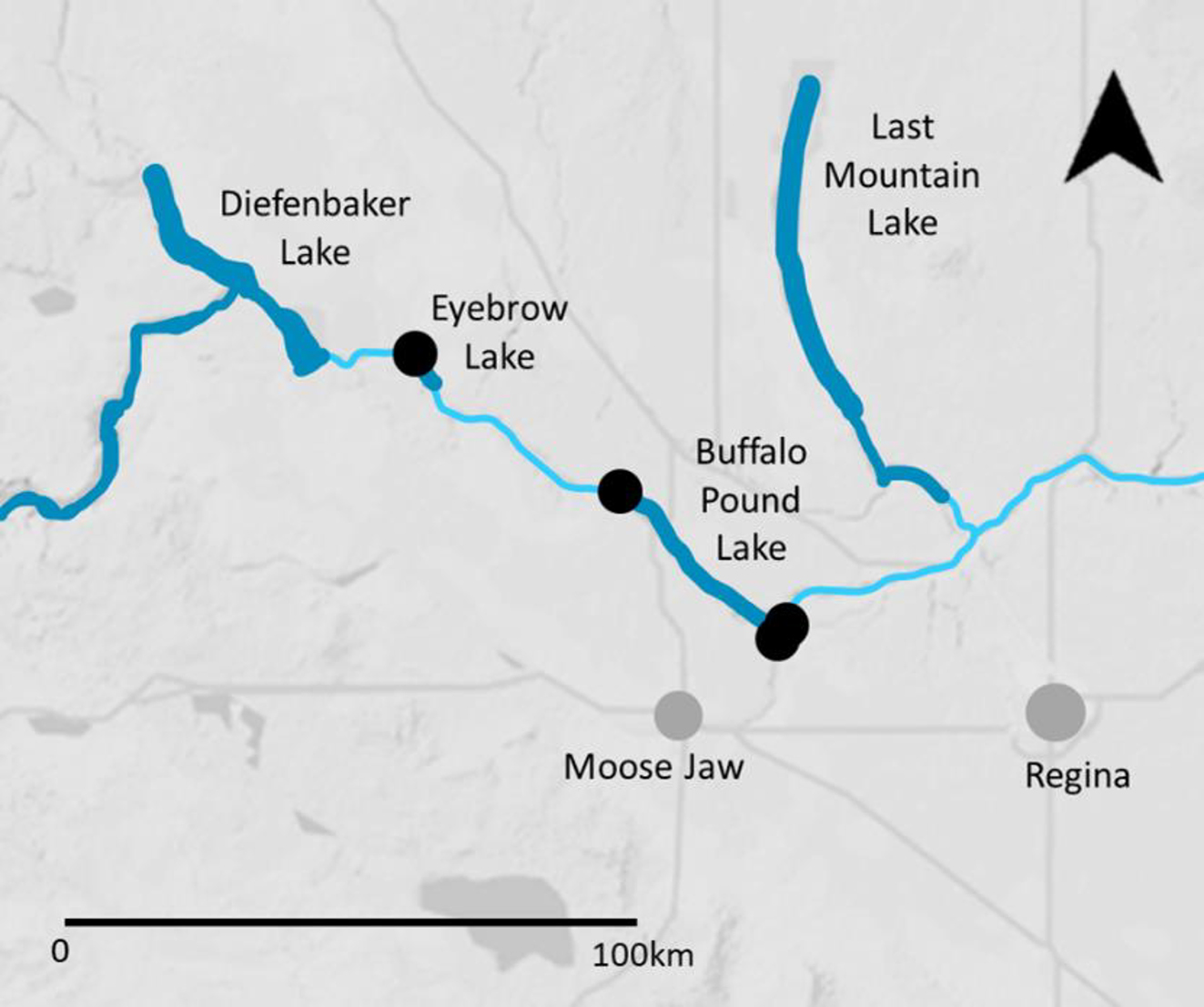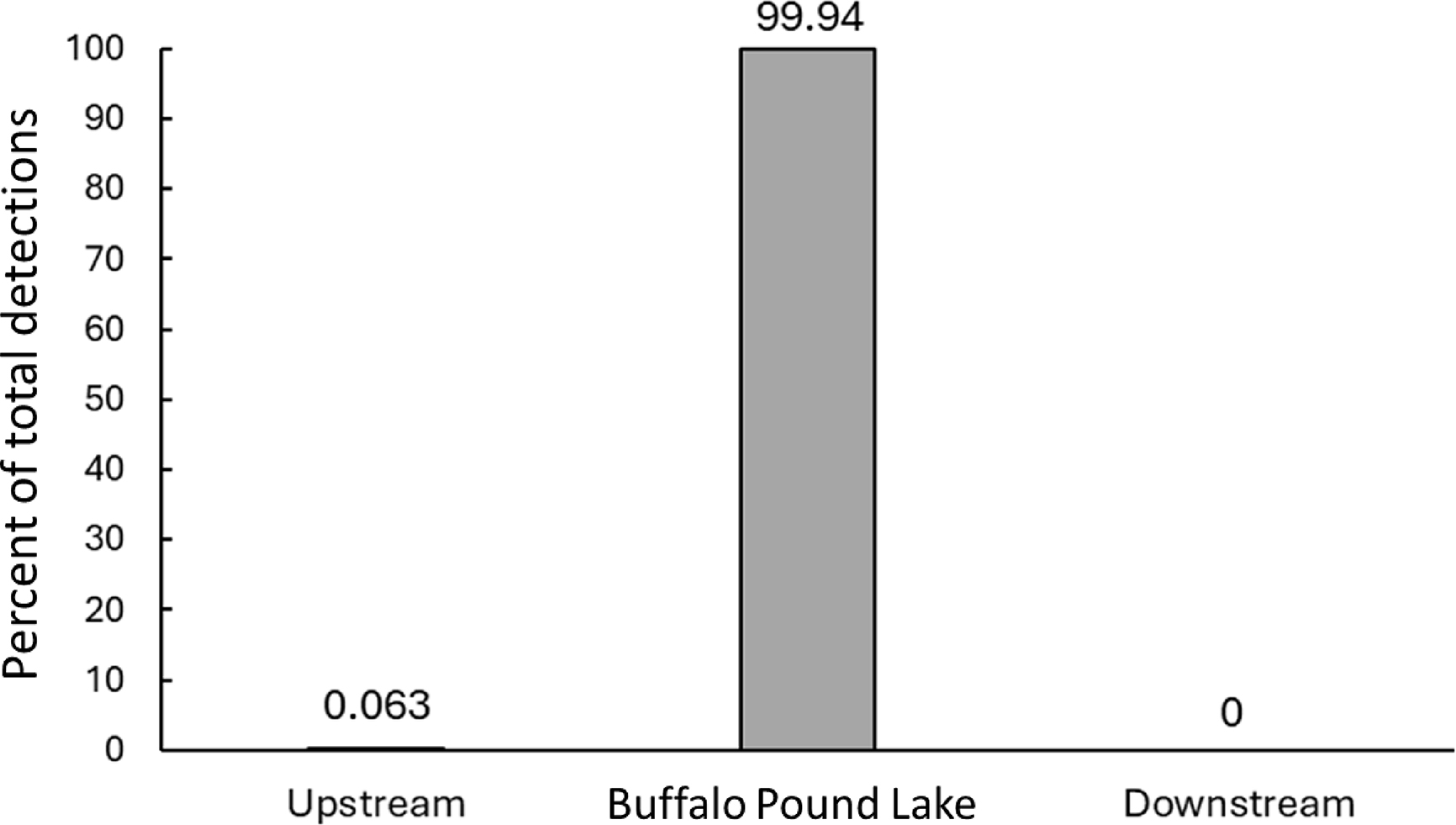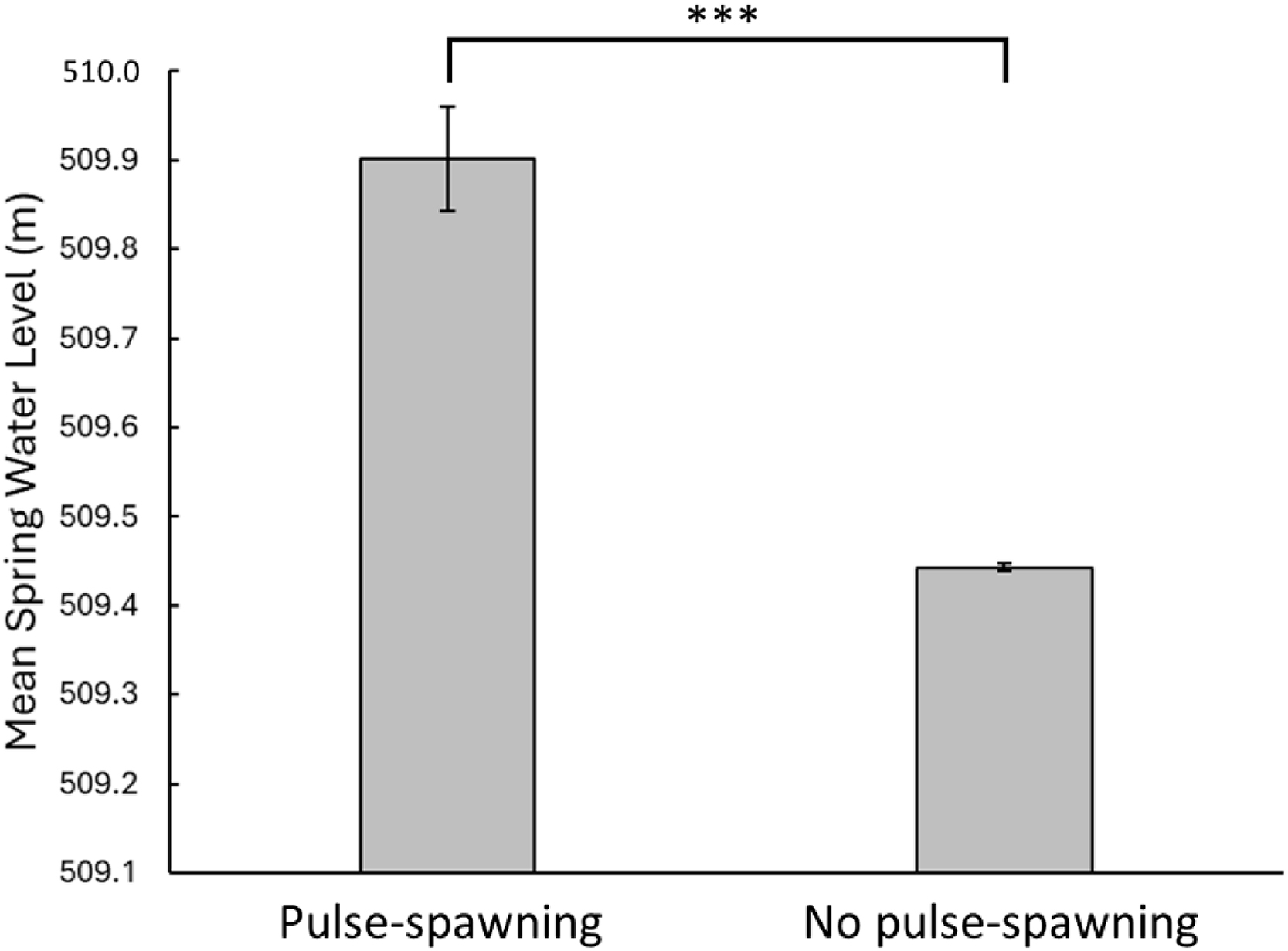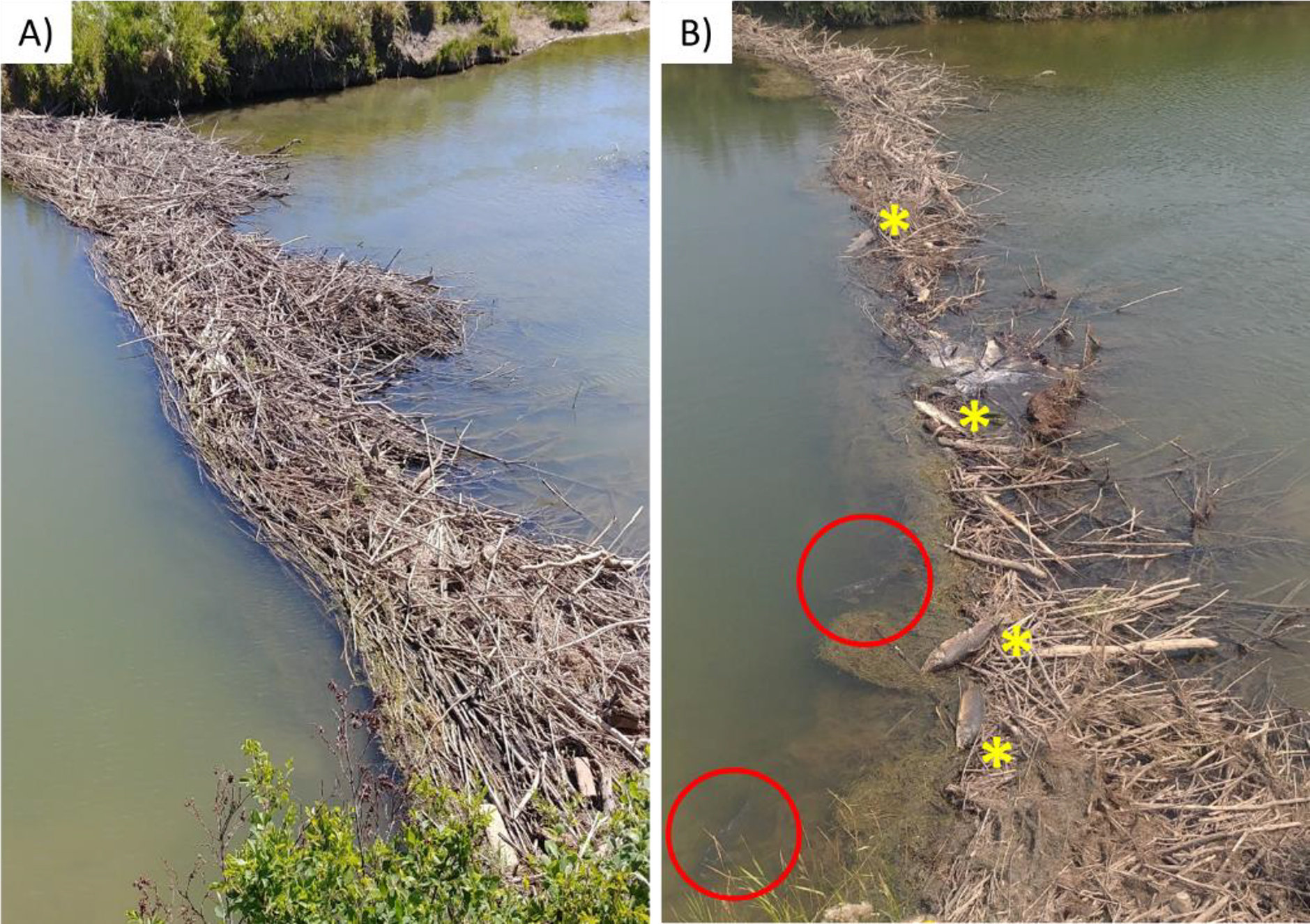Introduction
The prevalence of species that are becoming extinct worldwide is increasing at an alarming rate (
Pimm et al. 2014). Unfortunately, Canada is no exception. From 1970 to 2016, the country has experienced population size declines of 42% and 21% for mammal and fish species, respectively (
ECCC 2019). Furthermore, there has been a marked increase in described species at risk—species with populations at risk of declines in their natural habitat and receiving protection to allow for their recovery. As anthropogenic activities continue, and as more species become monitored but very few are removed, unsurprisingly, the number of species listed in Canada’s Species at Risk Act (SARA) has tripled since the Act’s establishment in 2003 (
ECCC 2022;
S.C. 2023). At present, SARA formally lists 706 species as at risk, that is, 18% of all Canada’s native vertebrates and those undergoing natural range expansion into Canada. Of these species, nearly a third are fishes (
S.C. 2023). Fishes might be disproportionately at risk because their ecosystems are much more susceptible to anthropogenic changes than their land-based counterparts (
Dudgeon et al. 2006).
The bigmouth buffalo (
Ictiobus cyprinellus, Valenciennes 1844) is a sucker fish of the Catostomidae family native to North America and is listed as a species of special concern under SARA due to its susceptibility to anthropogenic stressors such as habitat fragmentation and the introduction of invasive species (
DFO 2021). Their populations have been declining, making them the focus of many recent studies in the United States and Canada (
Enders et al. 2019;
Lackmann et al. 2019;
Lackmann et al. 2021;
Sauer et al. 2021;
Lackmann et al. 2023a,b). Prior to this recent interest, very little was known about bigmouth buffalo, beside the fact that they filter-feed on plankton in shallow waters and can grow to a large size, reaching lengths up to 95 cm and weights as heavy as 36 kg (
Johnson 1963;
Paukert 1999). They are thought to use a bet-hedging reproductive strategy, whereby individuals have lower reproductive fitness most years but may have exceptional reproductive success via heavy pulse spawning on floodplains, on years when plains get flooded at an optimal time and some offspring are able to survive, leading to the periodic recruitment of cohorts (
Johnson 1963;
Villa Martín et al. 2019;
Lackmann et al. 2023b). However, specific spawning sites for individual bigmouth buffalo populations remained primarily unknown, with a few exceptions (
DFO 2021;
Lackmann et al. 2023b).
Another recent addition to the bigmouth buffalo knowledge base is their upper age limit. In the past five years, aging assessments have progressed from inaccurate scale evaluation to otolith analyses (
Carlander 1969;
Paukert 1999). This revealed that the oldest documented bigmouth buffalo was 127 years old, making them the longest living freshwater teleost fish (
Lackmann et al. 2019;
Sauer et al. 2021;
Lackmann et al. 2023b). Furthermore, the upper age limit remains unknown as they have no natural predators as adults and they do not appear to show physiological senescence as they approach 100 years of age (
Johnson 1963;
Sauer et al. 2021); thus, they have the potential to live well beyond these 127 years.
The long-lived bigmouth buffalo is known to occupy lakes throughout central North America, with their native range extending throughout the Hudson Bay and Mississippi drainages (
Johnson 1963). In the United States, populations have been identified in 22 states, while in Canada, only the Laurentian populations and the Nelson-Saskatchewan population have been documented (
Johnson 1963;
Lackmann et al. 2019). The Nelson-Saskatchewan region includes bigmouth buffalo from the Qu'Appelle water basin (primarily the Qu'Appelle River system) in Saskatchewan as well as from the Lake Winnipeg water basin (Assiniboine River and Red River systems) in Manitoba. However, the specifics of these populations, such as where the fish primarily live within their river systems, whether they connect and mix, or their specific spawning habitats, is largely unknown.
Traditionally, bigmouth buffalo were considered a migratory species, being thought to travel throughout river systems when the conditions were appropriate. However, this migratory behavior may be more complex than previously thought. A recent study in 2019 found that bigmouth buffalo within the Lake Winnipeg watershed had consistently large individual home ranges, moving 4 to 620 km annually, with a mean home range size of 150 km (
Enders et al. 2019). However, it is unknown how these data relate to water level (not recorded in that study), and whether there are specific factors (e.g., flooding) that triggered this movement. It is also debated whether this information, and other biological traits, can be extrapolated across the entire Saskatchewan-Nelson population due to the differences between the Qu'Appelle River system and the Lake Winnipeg watershed. Even though the Qu'Appelle and Lake Winnipeg bigmouth buffalo likely belonged to the same population initially, dam construction without fishways beginning in 1939 resulted in habitat fragmentation, potentially splitting these populations genetically (
Johnson 1963). Furthermore, any natural migratory behavior of the fish is likely inhibited by any of the five dams along the Qu'Appelle River system that are present between the impassible Qu'Appelle Dam and where the river enters Manitoba, despite these dams being recently retrofitted to have fishways (
Johnson 1963;
Linløkken 1993;
Enders et al. 2019).
The presence of dams could be one factor contributing to the decline of bigmouth buffalo in the Qu'Appelle River system of Saskatchewan since the 1950s (
COSEWIC 2009), along with other factors such as commercial fishery harvesting of these fish, and the introduction of the aggressively invasive common carp (
Cyprinus carpio, Linnaeus 1758) to the river (
Atton 1959;
Hlasny 2003). Indeed, the bigmouth buffalo were so plentiful that a commercial fishery harvested bigmouth on Pasqua Lake from 1950 to 1983; however, severe harvest declines (an indicator of declining bigmouth buffalo populations) forced the closure of the fishery (
Lackmann et al. 2023b). Similar bigmouth buffalo population trends were also documented in research assessments of the Qu'Appelle River system and can be contrasted with the invasive common carp. Common carp were first detected in this region in the early 1950s (
Atton 1959), and
Johnson (1963) described common carp as “rare” in his 1955–1956 surveys of Last Mountain Lake, finding a common carp:bigmouth buffalo ratio of 1:132. Conversely, 45 years later, the common carp to bigmouth buffalo ratio was found to be 5:1 in Pasqua Lake (
Hlasny 2003). Recent work in 2013 recaptured only seven young-of-the-year bigmouth buffalo one month after a known spawning event involving more than 3000 bigmouth buffalo adults (
Lackmann et al. 2023b). Similarly, in 2016, a young-of-the-year common carp:bigmouth buffalo ratio of 33:1 was observed (R. Bryshun, unpublished data). It remains largely unknown what happens to bigmouth buffalo young-of-the-year following hatching.
As a result of this population decline, the Saskatchewan-Nelson River bigmouth buffalo were listed as a species of special concern by the Committee on the Status of Endangered Wildlife in Canada (COSEWIC) in 2009 (
COSEWIC 2009). In 2011, they were federally listed under SARA as a species of special concern (
DFO 2021), which remains their status as of 2024. A federal action plan was created in 2021 to evaluate the current population status and the severity of the assumed threats to the bigmouth buffalo which includes: (1) loss of spawning and rearing habitat, (2) habitat fragmentation, (3) recreational and commercial fishing, and (4) competition with common carp (
DFO 2021).
With several potential factors impacting bigmouth buffalo and so little information on their ecology, particularly within their Canadian range, conservation is challenging; research is necessary to identify some basic information, such as population range and migratory patterns or spawning and overwintering grounds as mandated in the federal action plan (
DFO 2021). This was the main objective of this study, with a focus on the Saskatchewan portion of the Saskatchewan-Nelson population, complementing the then ongoing studies on the Lake Winnipeg portion of the same population (
Enders et al. 2019).
Specifically, our research aimed to examine: (1) where bigmouth buffalo most often resided within the river system, (2) the fish’s migratory patterns, if present, and (3) whether their movement was inhibited by dams and habitat fragmentation. While fishways have been retrofitted to many dams in this river system beginning in 2000, little research has been performed on whether bigmouth buffalo use these fishways and whether the dams affected their dispersion and access to habitats (but for an initial study, see
Sereda et al. 2014).
This research consisted of a multi-year (2017–2019, and 2021) observational study whereby 44 bigmouth buffalo fish were successfully tracked using acoustic telemetry within the Saskatchewan Qu'Appelle River system. The prediction was that bigmouth buffalo would use habitat throughout the Qu'Appelle River to complete their life cycle; therefore, tagged individuals were expected throughout the system, with their movements changing between seasons. Movement pattern data would then be compared to the movement patterns of the populations within Manitoba’s Lake Winnipeg water basin, including those in the Red, Winnipeg, and Assiniboine rivers. Through compilation of all these findings, conservation agencies can formulate cohesive long-term population management recommendations, accounting for the challenges of protecting a species with a long lifespan that is susceptible to impacts from multiple natural and anthropogenic factors.
Methodology
Study species and field site
All research was performed in the Qu'Appelle River system in southern Saskatchewan. Adult bigmouth buffalo fish were collected in Buffalo Pound Lake (50°39′N 105°30′W) from April to August 2017. The study area ranged from Eyebrow Lake (50°57′N 106°11′W) to Round Lake (45°38′N 77°32′W) in 2017, and from Andy Rankin Marsh (50°45′N 105°41′W) to ∼2 km downstream of the Buffalo Pound Dam (50°34′N 105°19′W) in 2018, 2019, and 2021 (
Fig. 1). Data collection occurred during the ice-free months (May–October) of these years.
Animal ethics statements
All research was completed with approval of the University of Saskatchewan's University Animal Care Committee (UACC) and Animal Research Ethics Board (AREB), under Animal Use Protocol 20170034, following animal care guidelines established by the Canadian Council on Animal Care (CCAC).
Fish collection
All the bigmouth buffalo that were tagged in this study were captured in 2017 during multiple tagging events. In April, collection occurred using multiple downhaul traps (50 m lead, 2 m deep, 3 cm mesh) set up between Highway #2 (50°43′00′′N, 105°36′05′′W) and a deeper region North of the Buffalo Pound causeway (50°43′24′′N, 105°36′27′′W). Netted holding pens were used to house the fish overnight until tagging could occur the following day.
Bigmouth buffalo were also caught from May-August in a separate area of Buffalo Pound Lake using a different collection system. Instead of downhaul nets, gill nets were set near the mouth of the Qu'Appelle River where it enters the northern end of Buffalo Pound Lake (50°44′34′′N, 105 °38′13′′W). Three 100 m monofilament nylon gill nets of 17.8 cm, 20.3 cm, and 25.4 cm mesh sizes were deployed each collection event where they remained in the water for 4–8 h. The nets were checked hourly to reduce stress on the captured fishes as well as release any bycatch that occurred. Bigmouth buffalo that were caught in the nets were moved into a 227 L opaque plastic tub filled with fresh lake water and transported to shore for morphometric measurements and tagging.
Morphometric data collection
Captured bigmouth buffalo fish were weighed to the nearest kilogram using an electronic suspension scale with fish held in a wetted fish cradle. Fork length (distance from the nose to fork on the tail fin) measurements were taken using a fish board to the nearest millimetre. Any time fish were handled outside of the transportation tub, fresh water was administered to the gills to aid respiration.
Tagging procedures
Fish were tagged immediately after the morphometric measurements were taken. All fish were scanned for the presence of a Passive Integrated Transponder (PIT) tag, which would indicate the fish was a recapture from our study or from previous work. If a PIT tag from our study was present, the recapture was noted, and the fish was released back into the lake. If no PIT tag from our study was detected, one was injected into the dorsal musculature and the fish then underwent acoustic tag implantation. VEMCO V16-69 kHz acoustic transmitter tags were selected for their extended 6-year battery life and their signalling system. Tags send signals every 120 sec with a 10 sec randomization buffer to prevent scrambling of the acoustic signal, which could be caused by signals from other tagged fishes nearby. Of the 65 captured bigmouth buffalo, 63 were tagged with acoustics and two were excluded from acoustic tagging as they were either too stressed or appeared injured. While one captured bigmouth buffalo had a PIT tag, it was from a prior research study and thus acoustic tagging proceeded; we did not recapture any fish we had PIT tagged over the course of the study.
Prior to acoustic tagging, anesthetic was prepared by dissolving 100 g of buffered and diluted trimethylsulphate (MS-222) into a 227 L tub filled with lake water. The fish were placed in this anesthesia bath until they lost vestibular control (i.e., rotated ventral-side up), indicating adequate sedation for surgery. They were then placed in dorsal recumbency on a surgical table cushioned with foam. Scales were removed from the ventral abdomen, starting immediately caudal to the pelvic girdle, and moving caudally for approximately 5 cm. At this location, a scalpel was used to create a 3–5 cm incision through the abdominal wall. Care was taken to ensure the depth was just enough to enter the abdominal cavity without puncturing any underlying internal organs. An alcohol-sterilized acoustic tag was rinsed with sterile water before being inserted through this incision into the abdominal cavity. The incision was then closed with 2–0 coated Vicryl in a simple interrupted suture pattern, using a minimum of three sutures. The fishes were then moved into a recovery tub filled with 220 L of clean lake water. They remained in recovery until they regained vestibular control (i.e., dorsal side up) and swimming ability, after which they were released back into the lake. Throughout the surgical procedure, fish were provided with a continuous supply of fresh lake water over their gills to aid respiration; this was supplemented with MS-222, collected from the anesthetic bath, as needed to ensure the fish was maintained at an adequate anesthetic plane.
Receiver deployment
For each study season (2017, 2018, 2019, and 2021), VEMCO VR2Tx acoustic receivers were deployed in the Qu'Appelle River system during the ice-free season (i.e., May–October), however, the exact locations varied depending on the year. Each receiver was secured to a length of chain using nine large zip ties. The chain was then attached to an 18 kg cinderblock at one end and to a navigational buoy at the other, thus suspending it in the water column. To maximize the detection range of all receivers, those located in deep water had the receiver positioned just below the buoy and facing downward; those located in shallow water had the receiver positioned just above the cinderblock and facing upward. The receivers were checked monthly to ensure proper functioning and to download detection information to protect against data loss in the event of damaged or missing receivers.
Throughout all the study years, one receiver was always located 3 km upstream of Buffalo Pound Lake outside the entrance to Andy Rankin Marsh (
Fig. 2). This receiver location remained unchanged due to the importance of this marsh as a known potential spawning site (
Sereda et al. 2014;
DFO 2021;
Lackmann et al. 2023b) and its proximity to Buffalo Pound Lake allowed assessment of any individuals that left the lake upstream. In 2017, the nine remaining receivers were placed at key points for determining fish movement throughout the river system where they would detect any bypassing individuals (
Fig. 2). Three receivers were placed in Buffalo Pound Lake to determine if the tagged fish remained resident within the lake. To monitor upstream movement, in addition to the Andy Rankin Marsh receiver, a second one was placed farther upstream, just outside Eyebrow Lake. This receiver marks the farthest upstream site fish could travel, as it is backed by the Qu'Appelle Dam, an impassable dam at the southern end of Lake Diefenbaker.
To monitor downstream movement in 2017, first a receiver was placed ∼2 km downstream of Buffalo Pound Lake, just past Buffalo Pound Dam, to determine if fish could pass this barrier. Two additional receivers were placed farther downstream, at known spawning sites, to detect any potential migration of bigmouth buffalo for spawning purposes. The first was placed at Valeport Marsh, south of Last Mountain Lake, while the other was placed in the Qu'Appelle River at the entrance to Fairy Hill Marsh, downstream of Craven Dam. The Valeport Marsh receiver was lost in mid-July and replaced at the beginning of August. The two remaining receivers were placed the farthest downstream, in the Qu'Appelle Lake chain; one was located before the Katepwa Dam at the east end of Katepwa Lake; however, it was later moved upstream of the Echo Lake Dam in July after no fish were detected. The other receiver was placed downstream of Round Lake Dam and marked the final point at which the fish could be detected in this study before potentially moving farther downstream into Manitoba.
Based on the 2017 results, the receiver locations were altered in 2018 and 2019 to focus on fish movement within Buffalo Pound Lake rather than throughout the entire Qu'Appelle River system. The only spawning site location to be maintained in those two years was that of Andy Rankin Marsh as no receivers south of Buffalo Pound Lake recorded any fish detections in 2017 and it was deemed unlikely for any fish to pass downstream due to the presence of multiple beaver dams impeding fish movement.
In 2021, four acoustic receivers were deployed to assess whether tagged bigmouth buffalo had changed their river usage since 2019 (
Fig. 3). Two receivers were located upstream from Buffalo Pound Lake, situated in the same sites as in 2017—in Andy Rankin Marsh and Eyebrow Lake. Two receivers were located ∼1 km downstream from Buffalo Pound Dam, with both being positioned 200 m apart just upstream and just downstream of a large beaver dam. Through this placement, the ability of the fish to pass through these two physical obstructions could be evaluated. The receiver on the upstream side of the beaver dam was deployed in mid-June rather than May. Thus, fish attempting to migrate downstream could have been missed.
Data analysis
Movement data: All acoustic receiver tracking data were downloaded from the acoustic receivers using VEMCO's VUE program. The file editor tool was used to correct time drift that occurred in the receivers while VUE's internal detection verification was used to remove false detections. The raw detection data was exported from the VUE program as .csv files for further analysis.
The total number of detections at each receiver site was totaled to determine the frequency at which bigmouth buffalo used river sites external to Buffalo Pound Lake.
Water level data: Because bigmouth buffalo use a bet-hedging strategy across their extremely long lifespan that results in punctuated recruitment cohorts related to water levels (
Lackmann et al. 2021,
2023b), we analyzed Buffalo Pound Lake water level data to compliment movement data. Specifically, we used two-tailed
t tests to compare available daily water elevation data from Buffalo Pound Lake during the spawning periods of bigmouth buffalo (April and May) between confirmed pulse-spawning years (1997 and 2013) and confirmed nonpulse-spawning years (2017–2019, 2021) (as per observations and data in
Lackmann et al. 2023b). Since water elevation in Buffalo Pound Lake is carefully controlled at 509 m via the outflow dam, any change to the water level would be an indicator of more substantial river flowrates upstream of the lake.
Results
Over the course of this multi-year study, the receivers placed within Buffalo Pound Lake detected 44 of the 63 tagged bigmouth buffalo. Eleven fish were assumed to be either mortalities or the subjects of tag loss as they suddenly ceased moving and were only detected by a single receiver yearly after that point. A further eight fish were never detected following tagging, which we assumed to be the result of tag loss. Given the high locomotion activity level of the other tagged bigmouth buffalo, we assume that these undetected fish would have also been detected at some point, if they had indeed not suffered tag loss. It would be highly unlikely that a tagged fish would be able to pass by all receivers undetected and exit the lake, as our receiver orientation was designed to minimize this risk.
The fork length of the 44 tracked fish ranged from 59.4 to 86.8 cm with a mean ± SD of 69.7 ± 5.9 (594–868 mm with a mean ± SD of 697 ± 59 mm). Previous aging studies found that bigmouth buffalo reach sexual maturity at ages of 5–6 for males and 8–9 for females, and that individuals have a fork length of approximately 50–60 cm (500–600 mm) at 10 years of age (
Lackmann et al. 2019). In addition, in a sample of 52 individuals from Buffalo Pound Lake collected across approximately the same study period (2018–2021), the most recent year class evident was from 1997 (
Lackmann et al. 2023b). Therefore, we presumed that all 44 of the tracked study fish were adults of sexual maturity and thus expected to migrate to spawn.
In summary, all 44 of the studied bigmouth buffalo were detected throughout the entire study season (i.e., May–Oct) in 2017, 2018 and 2019. All detections (
n = 27 620) occurred within Buffalo Pound Lake and no individuals were detected passing any of the downstream or upstream receivers (
Figs. 2,
3) with the exception of a single fish which remained at the upstream Andy Rankin Marsh receiver for 18 h in 2021 (
n = 52). This fish only accessed the river during a single event on 18 June 2021, while the water temperature was 16.7 °C. It was assumed to have travelled directly back into Buffalo Pound Lake as it was not detected again at this receiver a second time; a second detection at this location would be expected for a fish that moved upstream and then returned to Buffalo Pound Lake. Across all study years, this individual was almost exclusively detected within Buffalo Pound Lake and not at the upstream site (
Fig. 4). When downstream receivers were present (i.e., 2017 and 2021), fish were never detected at these locations. Thus, in summary, the bigmouth buffalo in this study remained almost solely within Buffalo Pound Lake and did not migrate throughout the system.
The water level data analysis revealed that during confirmed pulse-spawning years (mean ± SD = 509.9 m ± 0.64 m), Buffalo Pound Lake had significantly higher water levels than those that occurred during our study which were nonpulse spawning years (mean ± SD = 509.4 m ± 0.0048 m) (t123 = 7.88,
p < 0.001) (
Fig. 5). Since bigmouth buffalo are documented to migrate to floodplains to spawn during flood years (
Johnson 1963;
Lackmann et al. 2023b), it is inferred that the four years of this project were nonflood years and, thus, likely nonmigration years.
To rule out any problems with receiver detection and functioning, we confirmed that other fishes (walleye, pike, and burbot) tagged for another study in this area and occurring over these same years were detected by the upstream receivers during their deployment (C. Somers 2019 (personal communication)). However, no tagged fishes from that study were ever detected downstream of Buffalo Pound Dam. This is likely due to the presence of a large beaver dam that served as a natural barrier in the river since 2017 and continued until after 2021 (
Fig. 6).
Discussion
One of the most notable findings of this study was that bigmouth buffalo did not move throughout the Qu'Appelle River system. Instead, individuals from the Buffalo Pound Lake population appeared to remain residents of the lake, with only one instance of movement into the adjoining river over the course of the four study years (2017–2019 and 2021). This is notable given that bigmouth buffalo in a mark-recapture study performed from 2010 to 2013 navigated upstream and downstream from Buffalo Pound Lake even in the absence of high flowrates in half of those years (2010, 2012) (
Sereda et al. 2014). It is unlikely that the sample size of our study was too small as the aforementioned project (
Sereda et al. 2014) had a sample size of only five fish, while we had 44 individuals tagged. Thus, there are three potential options which could explain why bigmouth buffalo did not leave Buffalo Pound Lake: (1) the flowrate was too low or did not increase at the proper time to trigger migration and a mass spawning event, (2) there were barriers interfering with movement (
Pennock et al. 2018), or (3) they simply chose to remain in the lake for reasons unknown to us.
Many long-lived species do not engage in reproductive behavior every year (
Lee et al. 2016;
van Noordwijk et al. 2018), and several fishes are documented to skip spawning during years when conditions are unfavorable (
Rideout and Tomkiewicz 2011). As the oldest living freshwater teleost (
Lackmann et al. 2019), there has been recent interest and research into the spawning behavior of bigmouth buffalo. There is some evidence suggesting that bigmouth buffalo have a synchronous breeding season interspersed with years of little to no reproduction (
Lackmann et al. 2023b). Modeling, verified with analyses done on real population distributions, illustrates that spring peak water level and the date of this peak are related to recruitment-success years for bigmouth buffalo (
Lackmann et al. 2021,
2023b). In years with unfavorable water levels, evidence suggests that few to no fish spawn (
Johnson 1963;
Osborn 1966;
Lackmann et al. 2023b). A combination of monitoring and population distribution analyses on the Qu'Appelle River population of bigmouth buffalo (this study population) has revealed that they likely only attempted to spawn ten times over a 66-year period (from 1956-2022), resulting in spawning gaps up to 14 years long (
Lackmann et al. 2023b).
While this study spanned four years, no mass spawning events were observed during that period, supported by observations during this study as well as by data in
Lackmann et al. (2023b). Furthermore, water level analysis indicated that the levels during the years of this study (2017–2019, 2021) were significantly lower than those in years with verified pulse spawning (
Fig. 5). Therefore, it is likely that bigmouth buffalo largely skipped migration during the years of this study as a result of the absence of high flowrates required to initiate a mass spawning event, an inference supported by the model by
Lackmann et al. (2023b) relating peak spring water level and pulse spawning events. Bigmouth buffalo were found throughout the Qu'Appelle River system in 2013 and 2014, which corresponds with the observed mass spawning event in Andy Rankin Marsh in 2013 (
Sereda et al. 2014;
Lackmann et al. 2023b).
Other bigmouth buffalo in this Saskatchewan-Nelson population (in the Lake Winnipeg watershed rather than the Qu'Appelle River water basin) have been found to exhibit large-scale movements annually over a 3-year period (
Enders et al. 2019). Water level and flooding was not documented during this study; thus, we cannot rule out the possibility that flooding occurred each spring and initiated this behavior. Alternately, this population could exhibit regular large- scale movement, independent of pulse-spawning behavior and water level triggers. In this case, the migration in this population could be a result of the Assiniboine River having a high flowrate. The Assiniboine River is a higher-order stream with a mean flowrate of 45 m
3/s which is much higher than the Qu'Appelle River which has a maximum flowrate of 14 m
3/s (
Hosseini et al. 2017). A higher flowrate and increased channel width makes the Assiniboine River more resistant to complete blockages by beaver dams and other naturally occurring barriers as well as potentially allowing more consistent access to other habitats of interest in the region. Thus, this population of bigmouth buffalo might be adapted to showing consistent migratory patterns to access consistently available ideal habitats (i.e., preferred habitats are not only accessible during flood years).
In addition to river flowrates, the presence of barriers, both natural and man-made could be affecting the ability of bigmouth buffalo to migrate throughout the Qu'Appelle River system. At the river outflow of Buffalo Pound Lake is Buffalo Pound Dam, a man-made retrofitted dam containing a fishway. While man-made dams, including the one at Buffalo Pound Lake, have been retrofitted with fishways that can be effective in mitigating the effects of this barrier (
Pennock et al. 2018), fishes do not necessarily always pass through them at the same frequency that they would pass through a natural river (
Linløkken 1993). However, we know that bigmouth buffalo have successfully used those fishways before (
Sereda et al. 2014), and during this study, common carp were present downstream of the dam, indicating that the fishway was not blocked. While we cannot rule out the possibility of common carp having migrated into this area from upstream, the large beaver dam almost completely obstructing the flow of the river would have made this unlikely (
Fig. 6).
Farther downstream, past Buffalo Pound Dam was a large beaver dam (
Fig. 6), first noted in 2017, which spanned the entire river width. Natural barriers (e.g., beaver dams, log jams) have been documented to disrupt migrations and prevent or delay spawning in various fish species (
Burchsted et al. 2014;
Cutting et al. 2018). The beaver dam south of Buffalo Pound Lake was present throughout all the study years (i.e., 2017–2021) and stranded common carp attempting to pass the dam were observed (
Fig. 6). The 2021 study year focused on testing which of the two barriers (the man-made dam or the beaver dam) limited bigmouth buffalo movement, through placement of acoustic receivers upstream (i.e., between the two dams) and downstream of the beaver dam. While no fishes, including bigmouth buffalo, were detected anywhere downstream of the beaver dam, no bigmouth buffalo were detected upstream either, indicating that these bigmouth buffalo fish were not coming near the dam and attempting to cross it between 2017 and 2021. This study cannot tease apart the cause of the lack of migration, i.e., whether (a) bigmouth buffalo were unable to pass the pair of dams and therefore stopped trying to pass or whether (b) they were voluntarily remaining within the lake. Indeed, bigmouth buffalo could behaviorally be foregoing migration and instead spawning and remaining within Buffalo Pound Lake until better spawning conditions arise as supported by
Lackmann et al. (2023b) who found evidence supporting this skip-spawning hypothesis.
Even though only a single individual accessed Andy Rankin Marsh, which is where mass spawning occurs during high-water years, it is possible that smaller spawning events may have occurred within the northern section of Buffalo Pound Lake (
DFO 2021;
Lackmann et al. 2023b). While conducting this study, a few bigmouth buffalo performing spawning behaviors were observed from a distance in the shallow northern reaches of Buffalo Pound Lake (R. Bryshun, personal observations), but no evidence of mass spawning events were noted. Additionally, work done in Andy Rankin Marsh in 2016 (a nonflood year) discovered three bigmouth buffalo young-of-the-year, indicating spawning had occurred despite the lack of a mass pulse-spawning event or the high flowrate to trigger this event to occur (R. Bryshun, unpublished data). Thus, while lack of high flowrates and potential barriers may impede mass pulse-spawning events from occurring, it is likely that bigmouth buffalo are still engaging in some spawning behavior within the lake.
In summary, this study reveals that the Qu'Appelle River basin population of bigmouth buffalo remain within Buffalo Pound Lake during nonflood years. While their downstream migration might be inhibited by physical obstructions, the absence of bigmouth buffalo movement upstream of the lake supports that this species uses a bet-hedging reproductive strategy and may largely skip spawning during some or many years. The Qu'Appelle River flowrates during the study period were too low to trigger spawning within the upstream marshes and the floodplains which would have been dry during these years.
Despite a resurgence in research efforts, exact information about the basic ecology of bigmouth buffalo within the Qu'Appelle River remains in need of further study. This particularly applies to further study of their spawning physiology and behaviors; with special attention given to investigating spawning during nonflood years. Further research is also required to examine the movement ecology of the fish in this population, to investigate potential barriers to fish migration, both natural and anthropogenic, and the ways in which these obstructions impact behavior over time. Appropriate management strategies within the Qu'Appelle system remain difficult to propose, especially given that management of such long-lived fish species has not been attempted in a freshwater environment such as this. However, the results of this study provide valuable information for conservation efforts—it is now known that the Qu'Appelle population of bigmouth buffalo primarily remains within Buffalo Pound Lake during nonflood years. With this knowledge, regulatory bodies can better direct strategies to protect these fish.
